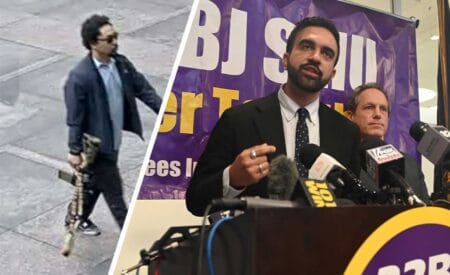The latest developments from the Supreme Court provide a vital update for all advocates and followers of Second Amendment rights.
The 2A Attorneys in Gray v. Jennings Delaware “assault weapon” ban litigation have filed a submission to SCOTUS as the three AR-15/Magazine ban cases continue their move through the Court’s consideration process. Mark Smith Four Boxes Diner discusses.
The case of Gray v. Jennings, alongside other pivotal cases concerning AR-15 and magazine bans, is coming to a head as the Supreme Court expedites its processes, hinting at significant sessions in early 2025 that could shape the future of gun rights in America.
The Essence of the Appeal
The Gray v. Jennings case, originating from Delaware’s imposition of an “assault weapon” ban, is a critical point of contention. The appeal to the Supreme Court is not just about reversing a lower court’s decision but about setting a precedent on how similar cases are handled nationwide. The legal team has pushed for an expedited review, aiming for the Supreme Court justices to discuss this during their January 2025 conferences.
Why This Matters
For those deeply invested in upholding the Second Amendment, these cases represent more than legal disputes; they symbolize the ongoing battle for maintaining the right to bear arms as envisioned by the framers of the Constitution. The outcomes could either reinforce the Second Amendment or lead to more stringent controls on firearm ownership and usage.
Key Dates to Watch
Mark your calendars for these crucial dates:
- January 10, 2025: The first conference where the Supreme Court might decide to hear the case.
- January 17 and 24, 2025: Subsequent conferences that could further influence the course of this legal battle.
Depending on the justices’ decisions, each of these dates could be a turning point in whether to take up the cases for a full hearing or deny them outright.
Live Inventory Price Checker
|
|
Cmc Triggers Cmc Bbl-556-001 AR15 5.56 NATO 7.5" Button Rifled | Ammunition Depot | $ 132.99 |
|
|
|
Black Rain Ordnance Billet 5.56 AR15 Rifle 16" 30rd Collapsible Stock (FDE Cerakote) | Ammunition Depot | $ 1517.49 $ 1286.99 |
|

|
KAK 5.56 20" Rifle Gas GOVT Pencil AR15 Barrel- Phosphate | KAK Industry | $ 199.99 |
|

|
Ar-15/M16 5.56 Enhanced Bolt Completion Group - Ar15 223 Bolt Completion Group | Brownells.com | $ 126.99 |
|
Gabriel Gray, et al., Petitioners v. Kathy Jennings, Attorney General of Delaware, et al.: Background of the Case
Gray v. Jennings centers on a legal challenge to Delaware’s ban on so-called “assault weapons,” which includes certain models of semi-automatic rifles like the AR-15. The case emerged from gun owners and Second Amendment advocates challenging the state’s legislation, arguing that it infringes upon their constitutional rights under the Second Amendment, which guarantees the right to keep and bear arms.
Legal Journey
The lawsuit was initially filed in the federal courts of Delaware and eventually made its way to the U.S. Court of Appeals for the Third Circuit. The appellate court upheld Delaware’s law, applying a test that many Second Amendment advocates feel does not properly weigh the historical tradition of firearm regulation in America. Critics of the decision argue that the court did not adequately consider the significance of these firearms in lawful self-defense and recreational use, which they claim are common uses protected by the Second Amendment.
Core Legal Issues
At the heart of Gray v. Jennings are questions about the standards used to evaluate Second Amendment claims and the types of weapons that fall under the protection of the Second Amendment. The plaintiffs argue that widely owned semi-automatic rifles are used for lawful purposes and should not be categorically banned. They also contend that the criteria used by the Third Circuit to uphold the ban—emphasizing public safety concerns over individual rights—are inconsistent with Supreme Court precedents that affirm the individual right to own commonly used firearms for lawful purposes.
Significance of the Case
Gray v. Jennings is significant for several reasons:
- Precedential Impact: The case could set a crucial precedent for how courts interpret the Second Amendment, especially following the Supreme Court’s landmark decisions in District of Columbia v. Heller and McDonald v. City of Chicago, which affirmed the right to keep and bear arms as fundamentally individual.
- Legal Standards: The decision will likely address the legal standards that should be applied when evaluating restrictions on firearms, potentially influencing future gun legislation and judicial decisions across the United States.
- Public Policy and Sentiment: As gun control remains a hotly debated issue in America, the outcome of this case could influence public policy and legislative approaches to firearm regulations at both state and federal levels.
Looking Ahead
As Gray v. Jennings proceeds to possibly be heard by the Supreme Court, its implications stretch far beyond Delaware. The case represents a critical junction in the ongoing debate over the balance between gun rights and public safety, making it a landmark case with the potential to affect millions of gun owners across the country. The decision could either reinforce the protective scope of the Second Amendment or grant states more leeway in regulating firearms, thereby shaping the landscape of American gun rights for years to come.
Buckle Up
As we approach these pivotal dates, it’s crucial for supporters of the Second Amendment to stay informed and engaged. The decisions made in early 2025 could redefine the landscape of gun rights in America. Remember, the fight for maintaining our freedoms is ongoing, and each legal milestone plays a crucial role in this enduring battle.
Stay tuned, stay informed, and most importantly, stay committed to the cause. The preservation of our rights often hinges on our collective vigilance and action.
SCOTUS Forces Maryland to Deliver On Key Second Amendment Case Argument ~ VIDEO






The only restrictions the founders and Constitution allow concerning firearms is the blanket prohibition of government having ANY authority whatsoever over citizens’ arms. The only constitutional law on firearms is that the government is forbidden to infringe on our right to keep and bear arms. Every single law the government has passed that limits, restricts or attempts to control citizens’ access to, ownership of or carrying of firearms is blatantly unconstitutional garbage we will not abide.
If the government can ban semi-auto rifles because of certain features then they can ban bolt action rifles. Then they can ban box magazines. Then they can ban muzzle loading flintlocks. There are no limits if these assault weapons bans are allowed to stand.
I refuse to ask any of these government beurocrat POS for the right to exercise my second amendment rights that are guaranteed under the bill of rights . If they make any ruling that does not align with the constitution then they can eat shit .
No one has an “assault weapon” until something is used as one.
I’m about to go out and put some ant bait on some Fire Ants. That will make the ant bait an “assault weapon.”
The way to reduce assaults is to permanently remove repeat violent offenders from society. The way to accomplish that is to charge seditionists. However, that would immediately destroy the DNC, and the Conservatives would then have no reason to exist, and they won’t let that happen.
It’s an ongoing situation as long as humans are what we are.
The State of Delaware fails the strict scrutiny standard in its semi-automatic rifle ban. They premise the ban on the State’s power to restrict an enumerated natural right in the interest of public safety. In order to demonstrate that public safety interest they must produce evidence that a particular type of firearm presents a clear danger. Based upon crime statistics the semi-automatic rifle fails that test every time. Those rifles are a subcategory of long arms and constitute a tiny fraction of firearms used in the commission of crimes. The State’s case is based upon emotion driven mythology and not… Read more »
Play it again, Sam….once again, I ponder, when will our “oh, so smart ESQUIRES” finally proved their worth in pleading the crux of the case….. “Penning 2A, our Founders intended citizens to show up to defend “..the security of a free state..” with their fully current technology military capable keep’n’bearables, not Libturd soothing rubber band guns’n’SuperSoakers.” Fully automatics, short everythingies, loudenearsplitteners for all!!! Where has this point actually been presented in court? ESQUIRES, UP!!! But, then, the 2A issue thingy is BIG BUSINESS for both sides. Should an esquire successfully plead the above point, or citizens “man up”, settle the… Read more »
>common uses protected by the Second Amendment<
Common uses, uncommon uses, this use, that use, every and all potential uses are protected by the Second Amendment. Why singel out just one? Whether an object COULD be used for something illegal is of no consequece until it IS used for something illegal.
HLB